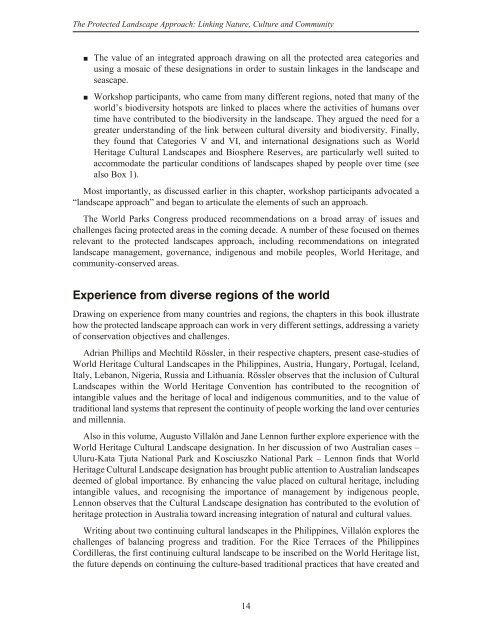The Protected Landscape Approach - Centre for Mediterranean ...
The Protected Landscape Approach - Centre for Mediterranean ...
The Protected Landscape Approach - Centre for Mediterranean ...
Create successful ePaper yourself
Turn your PDF publications into a flip-book with our unique Google optimized e-Paper software.
<strong>The</strong> <strong>Protected</strong> <strong>Landscape</strong> <strong>Approach</strong>: Linking Nature, Culture and Community<br />
<br />
<br />
<strong>The</strong> value of an integrated approach drawing on all the protected area categories and<br />
using a mosaic of these designations in order to sustain linkages in the landscape and<br />
seascape.<br />
Workshop participants, who came from many different regions, noted that many of the<br />
world’s biodiversity hotspots are linked to places where the activities of humans over<br />
time have contributed to the biodiversity in the landscape. <strong>The</strong>y argued the need <strong>for</strong> a<br />
greater understanding of the link between cultural diversity and biodiversity. Finally,<br />
they found that Categories V and VI, and international designations such as World<br />
Heritage Cultural <strong>Landscape</strong>s and Biosphere Reserves, are particularly well suited to<br />
accommodate the particular conditions of landscapes shaped by people over time (see<br />
also Box 1).<br />
Most importantly, as discussed earlier in this chapter, workshop participants advocated a<br />
“landscape approach” and began to articulate the elements of such an approach.<br />
<strong>The</strong> World Parks Congress produced recommendations on a broad array of issues and<br />
challenges facing protected areas in the coming decade. A number of these focused on themes<br />
relevant to the protected landscapes approach, including recommendations on integrated<br />
landscape management, governance, indigenous and mobile peoples, World Heritage, and<br />
community-conserved areas.<br />
Experience from diverse regions of the world<br />
Drawing on experience from many countries and regions, the chapters in this book illustrate<br />
how the protected landscape approach can work in very different settings, addressing a variety<br />
of conservation objectives and challenges.<br />
Adrian Phillips and Mechtild Rössler, in their respective chapters, present case-studies of<br />
World Heritage Cultural <strong>Landscape</strong>s in the Philippines, Austria, Hungary, Portugal, Iceland,<br />
Italy, Lebanon, Nigeria, Russia and Lithuania. Rössler observes that the inclusion of Cultural<br />
<strong>Landscape</strong>s within the World Heritage Convention has contributed to the recognition of<br />
intangible values and the heritage of local and indigenous communities, and to the value of<br />
traditional land systems that represent the continuity of people working the land over centuries<br />
and millennia.<br />
Also in this volume, Augusto Villalón and Jane Lennon further explore experience with the<br />
World Heritage Cultural <strong>Landscape</strong> designation. In her discussion of two Australian cases –<br />
Uluru-Kata Tjuta National Park and Kosciuszko National Park – Lennon finds that World<br />
Heritage Cultural <strong>Landscape</strong> designation has brought public attention to Australian landscapes<br />
deemed of global importance. By enhancing the value placed on cultural heritage, including<br />
intangible values, and recognising the importance of management by indigenous people,<br />
Lennon observes that the Cultural <strong>Landscape</strong> designation has contributed to the evolution of<br />
heritage protection in Australia toward increasing integration of natural and cultural values.<br />
Writing about two continuing cultural landscapes in the Philippines, Villalón explores the<br />
challenges of balancing progress and tradition. For the Rice Terraces of the Philippines<br />
Cordilleras, the first continuing cultural landscape to be inscribed on the World Heritage list,<br />
the future depends on continuing the culture-based traditional practices that have created and<br />
14

















